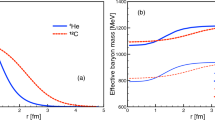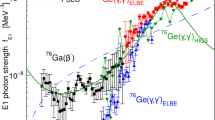Summary
We have examined theoretically the capture of K− at rest by deuterium, principally in terms of final state YN interactions. In particular we calculated total rates, the momentum spectra associated with the production of Σ−+n+π+ and Λ0+p+π−, and the corresponding angular correlation. (The latter are not found to be useful except perhaps as a check). On the basis of total rates it is known that capture from theP Bohr orbit through thes wave KN channel probably dominates. This assignment is reinforced by the spectrum of the low momentum Λ peak (Λ’s converted from Σ’s). A definitive check can be made when a somewhat better converted Λ spectrum is measured, since one should observe a double peak (with a cusp at the maximum pion momentum associated with production) if this assignment is correct. Analysis of the high pion momentum Λ peak (directly produced Λ’s), using this assignment reveals that the spectrum is insensitive to the YN interaction and yet does not seem to agree with the data. This spectrum shape (and that for Σ−nπ+) depends significantly on the KN → Yπ absorption process off the energy shell, which in turn depends on the KN scattering lengths. Preliminary comparison of data and theory indicates a large negative real part for the isotopic spin one KN scattering length. Finally, from the relative rate for conversion of Σ’s into Λ’s, we deduce a minimum value for the imaginary part of the isotopic spin 1/2p wave σN scattering length. The result, larger than the pion Compton wavelength, indicates a very strong potential in the ΣN channel and/or coupling ΣN and ΛN channels, a potential much stronger than indicated by the universal pion baryon interaction. Capture from theS Bohr orbit is also extensively discussed. In this case, the spectra associated with Σ− and direct Λ production are sensitive to the final YN interaceion.
Riassunto
Abbiamo preso in esame da un punto di vista teorico la cattura K− a riposo da parte del deuterio principalmente in funzione delle interazioni YN dello stato finale. Abbiamo calcolato in particolare i rapporti totali, gli spettri dell’impulso associati alla produzione di Σ−+n+π− e di Λ0+p+π− e la correlazione angolare corrispondente (non si è riscontrata l’utilità di quest’ultima se non forse come controllo). In base ai rapporti totali si riscontra che la cattura da parte dell’orbitaP di Bohr attraverso il canale KN dell’ondas risulta con ogni probabilità predominante. Tale ipotesi è rafforzata dallo spettro del picco delle Λ di basso impulso (Λ convertite da Σ). Si può compiere un controllo definitivo quando si misuri lo spettro delle Λ un po’ meglio convertito, in quanto, se tale ipotesi è esatta, si osserverebbe un doppio picco (con una cuspide nell’impulso pionico massimo associato alla produzione). L’analisi del picco delle Λ di alti impulsi pionici (Λ prodotte direttamente) che faccia uso di questa ipotesi, rivela che lo spettro è insensibile alle interazioni YN e che non sembra ancora essere in accordo con i dati. Tale forma dello spettro (e quello per le Σ−nπ+) dipende in modo significativo dal processo di assorbimento KN → Yπ all’esterno dello strato di energia, il quale a sua volta dipende dalle lunghezze di scattering KN. Un confronto preliminare fra i dati e la teoria indica un’ampia parte reale negativa per la lunghezza dello scattering KN dello spin isotopico uno. Dal rapporto relativo alla conversione delle Σ in Λ, deduciamo infine un valore minimo per la parte immaginaria della lunghezza di scattering ΣN dell’onda dello spin isotopico 1/2p. Il risultato, maggiore della lunghezza d’onda Compton del pione, indica un potenziale molto forte nel canale ΣN e, se si accoppiano i canali ΣN e ΛN, un potenziale molto più forte di quello indicato dall’interazione universale pione-barione. Si discute estesamente anche la cattura dall’orbitaS di Bohr. In questo caso gli spettri associati alla produzione diretta di Σ− e Λ sono influenzati dall’interazione YN finale.
Similar content being viewed by others
References
N. Horwitz, D. Miller, J. J. Murray, M. Schwartz andH. D. Taft:Bull. Am. Phys. Soc.,3, 363 (1958), and private communication.
R. Karplus andL. S. Rodberg:Phys. Rev.,115, 1058 (1959). We would like to thank Drs.Karplus andRodberg for communicating their results before publication. See alsoL. B. Okuń andM. I. Šmuškevič:Žurn. Ėks. Teor. Fiz., (U.S.S.R.),30, 979 (1956) [translation:Sov. Phys.,3, 792 (1956)].
G. Breit:Phys. Rev.,107, 1612 (1958);R. G. Newton:Ann. Phys.,4, 29 (1958);A. M. Lane andR. G. Thomas:Rev. Mod. Phys.,30, 257 (1958).
G. F. Chew andG. C. Wick:Phys. Rev.,85, 636 (1952);G. F. Chew andM. L. Goldberger:Phys. Rev.,87, 778 (1952);M. Gell-Mann andM. L. Goldberger:Phys. Rev.,91, 398 (1953).
R. H. Dalitz andS. F. Tuan:Phys. Rev. Lett.,2, 425 (1959);M. Ross:Phys. Rev.,112, 986 (1958).
L. I. Shiff:Quantum Mechanics (New York, 1955), pp. 77 and 79.
R. H. Dalitz andS. F. Tuan:Ann. Phys.,8, 100 (1959).
M. Ross andG. Shaw:Phys. Rev. (to be published).
A. H. Rosenfeld:Bull. Am. Phys. Soc.,3, 363 (1958).
T. B. Day andG. A. Snow:Phys. Rev. Lett.,2, 59 (1959).
R. H. Dalitz andB. W. Downs:Phys. Rev.,111, 967 (1958);M. H. Ross andD. B. Lichtenberg:Phys. Rev.,110, 737 (1958).
D. B. Lichtenberg andM. H. Ross:Phys. Rev.,107, 1714 (1957).
A mechanism has been suggested byDay, Snow andSucher:Phys. Rev. Lett.,3, 61 (1959), which could lead toS Bohr orbit captureΓ(S, s) and essentially noP orbit captureΓ(P, s). We feel the converted Λ spectrum shape is one good means of testing this possibility empirically. If indeedΓ(S, s) is the dominant mode, we have shown that the present data for the direct Λ spectrum is probably consistent with hyperfragment data without consideration of a strong energy dependence of the KN T-matrix (see below), and that the conversion ratioR can be explained by a moderately small imaginary part of thes wave scattering length. The latter result would not be in qualitative disagreement with the predictions of the universal pion baryon interaction (see below).
J. C. Jackson, D. G. Ravenhall andH. W. Wyld jr.:Nuovo Cimento,9, 834 (1958).
Our result of a large negative real part in the isotopic spin one, scattering length must be regarded as very preliminary. This sign disagrees with that found byJ. D. Jackson andH. W. Wyld jr.:Phys. Rev. Lett.,2, 355 (1959).
M. Ross andG. Shaw:Ann. Phys. (to be published).
M. Gell-Mann:Phys. Rev.,106, 1296 (1957).
Author information
Authors and Affiliations
Additional information
Supported in part by the National Science Foundation.
Rights and permissions
About this article
Cite this article
Kotani, T., Ross, M. Analysis of K− absorption in deuterium. Nuovo Cim 14, 1282–1309 (1959). https://doi.org/10.1007/BF02962351
Received:
Published:
Issue Date:
DOI: https://doi.org/10.1007/BF02962351




